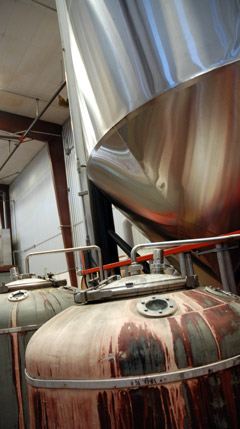 Mark Dredge poses a question at Pencil & Spoon that’s a variation on one discussed at length in American blogs, but adds a new perspective when asking “Are we in a New Wave of brewing?”
Mark Dredge poses a question at Pencil & Spoon that’s a variation on one discussed at length in American blogs, but adds a new perspective when asking “Are we in a New Wave of brewing?”
He starts with film to make his point, specifically the French Nouvelle Vague, quickly moving on to “small groups of brewers, pushing each other forward, exciting and exuberant, articulate and literate in the language of beer, each with their own authoritative stamp which makes the drinker know that they’ve just enjoyed a beer by that particular brewery.”
Of course what’s new in the UK isn’t necessarily new to us.
Dogfish Head are at the forefront of this ‘movement’ in the US and always have been – they are the Jean-Luc Godard of beer. The beer itself, the brand, the marketing, it all points towards a New Wave. Their 60, 90 and 120 Minute IPAs use the innovative technique of continual hopping (see: Godard’s jump cuts).
OK, he’s got to work a little on his history. While continual hopping makes a good story and good beer the real innovations in hopping — embracing true bitterness, making massive late hop additions for more flavor, dry hopping, etc. — started in California before Sam Calagione opened Dogfish Head Craft Brewery in 1995.
And California brewers aren’t given up the hop crown easily. Just look at the IPA, Double IPA, Imperial Red and similar category results from the recently concluded Great American Beer Festival competition.
Beyond that many good questions posed (as well as in the comments, be sure to make it to Zak’s). Right to the end: “Are we in a New Wave of British and world brewing? Or is this whole thing just the natural progression of brewing along its own course?”
Perhaps it’s possible to answer yes to both.
Interesting angle; made me think of this interview with Jim Mills of Caldera Brewing out of Ashland (Oregon) wherein he mentions the “third wave of brewers”:
“I think the other thing-its not really just in this town but in general, but in Oregon and across the nation-the third wave of breweries…we’re the second wave..you know Ninkasi and some of the guys in Enterprise and whatnot…they’ve made the big guys step up. Like BridgePort is doing that Kriek now. They would have never done that ten years ago…. It’s a tertiary wave of brewers coming in and spurring all the other breweries to get unique and creative because that’s what the consumers are wanting right now.”
I’m wondering if a “fourth wave” might be made of all of these “extreme collaboration” beers coming out lately.
I have a deep distrust of anyone who considers brewers to be “artists”.
I must now lodge the requisite parochial complaint about your corrected version of brewing history:
[E]mbracing true bitterness, making massive late hop additions for more flavor, dry hopping, etc. — started in California before Sam Calagione opened Dogfish Head Craft Brewery in 1995.
Reserving all credit to California, when the entire West Coast was caught in the hops love affair, is a bit off. Sierra Nevada was certainly an early pioneer with hops, but by the mid-1980s, a number of breweries in Washington and Oregon were also getting bitter. It’s one thing to credit a brewery with certain innovations, but if you’re going to cite a regional trend, you’re going to have to make this a West Coast thing.
Oh, and for what it’s worth, I do think the art analogy works extremely well with brewing. I’m not sure the New Wave is the best analogue, but the larger point is well made. I’ve written about it before myself.
Can I get “where in the beer world” points for that picture?
Sorry, Swordboarder, no. Only thing missing from the photo is you.
Jeff. No doubt Bert Grant, John Maier, John Harris, etc., were on that bitterness train early. Producing a lot of lovely hoppy beers many would argue were more sensible and balanced.
I could have wimped out and just typed West Coast, saving myself from grief, but I wanted to make the point about late and “inefficient” hopping that began well south of Sierra Nevada.
Perhaps Northwest brewers were also doing this early on, but I’ve never read or heard about it. It is something I intend to pursue next trip that way.
Funny, a brewer that moved up from San Francisco to Seattle was saying a similar thing, people from the northwest brew more bitter than flavorful IPAs.
I do have brew logs from 1983 for a Pale Ale that has a T-10 addition of cascade in the whirlpool. I don’t know if that counts for anything….
Interesting to see your take. In the UK this is a much more recent thing than in the US and the younger brewers are following the US lead. As for DFH, I know that East Coast brewers were hopping their beers two decades before Sam, but it’s more of a mentality thing, wrapped up in the marketing and the whole feel of the brewery. Filmmakers were using unusual techniques before Godard et al became known… Ultimately, I was trying to look at beer from a different angle and add a film allusion, which I think just about works…!!
I like Joe’s third/fourth wave of brewers idea, that’s nice.
And as for Ron’s comment that he distrusts people who think brewers are artists… I COMPLETELY disagree. Brewing is an art, a creation of something new. Some brewing is not art, it’s just reprinting, but the initial creation of new craft beers is art.
Cheers for picking up on the piece 🙂
Calling brewers artists is just pretentious rubbish. Exactly what brewing doesn’t need. After all, you call it “craft beer” not “art beer”.